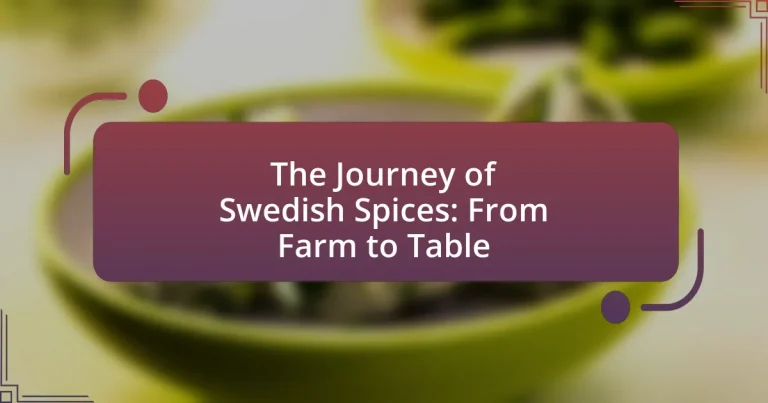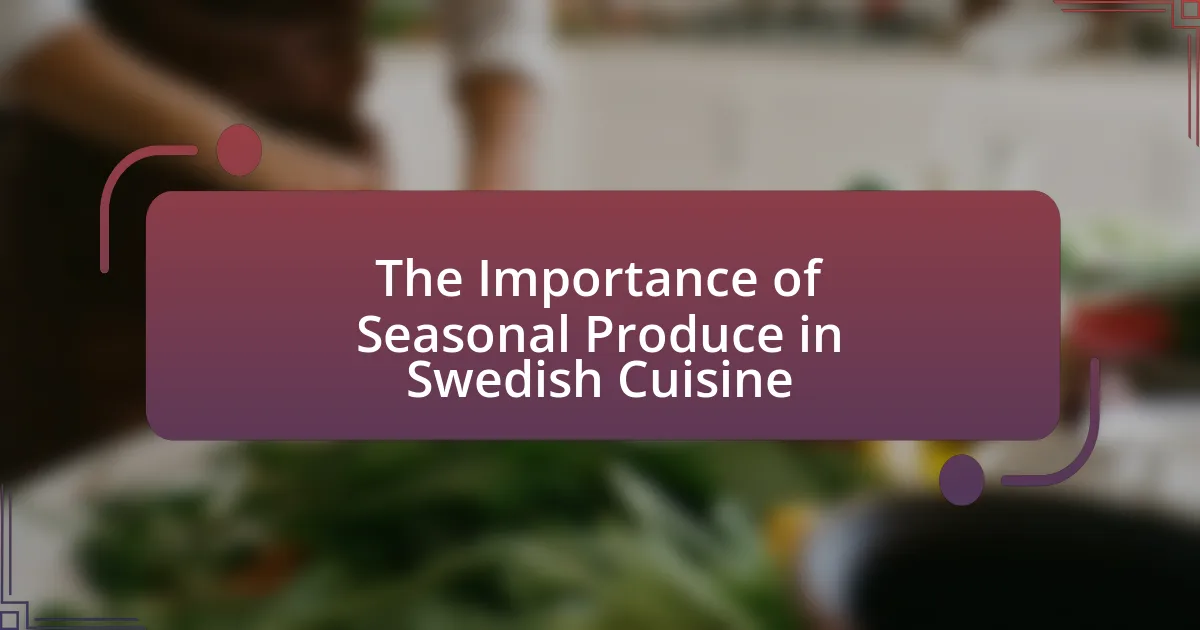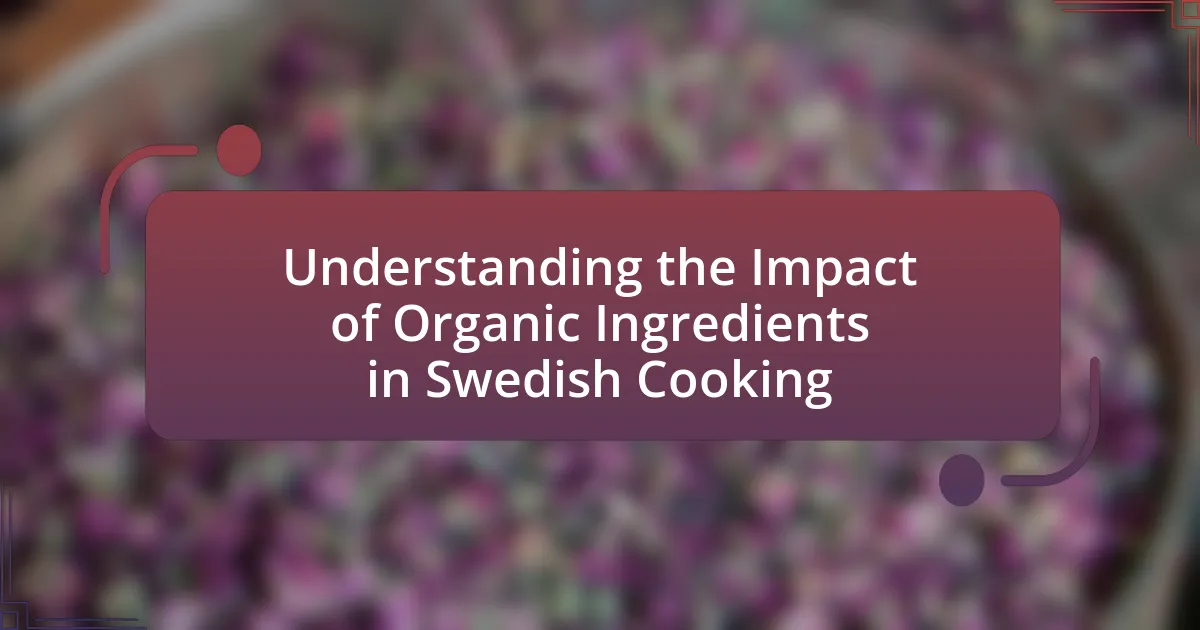The article explores the journey of Swedish spices from farm to table, detailing the processes of cultivation, harvesting, processing, and distribution. It highlights the organic farming practices employed in Sweden, the types of spices commonly grown, and the impact of local climate on flavor profiles. The article also discusses the importance of sustainability in spice farming, the steps involved in processing, and the distribution channels that bring these spices to consumers. Additionally, it examines the culinary uses of Swedish spices, modern trends in their application, and offers tips for effective use in cooking.

What is the journey of Swedish spices from farm to table?
The journey of Swedish spices from farm to table involves cultivation, harvesting, processing, and distribution. Initially, spices such as dill, coriander, and mustard are grown in Sweden’s suitable climate and soil conditions, primarily in regions like Skåne. After cultivation, these spices are harvested at their peak maturity to ensure optimal flavor and quality. Following harvest, the spices undergo processing, which may include drying, grinding, or packaging, to prepare them for market. Finally, the processed spices are distributed to retailers and consumers, making them available for culinary use in homes and restaurants across Sweden. This entire process ensures that the spices retain their unique flavors and nutritional properties, contributing to Swedish cuisine.
How are Swedish spices cultivated?
Swedish spices are cultivated primarily through organic farming practices that emphasize sustainability and biodiversity. Farmers in Sweden often utilize greenhouses to extend the growing season, allowing for the cultivation of herbs like dill, parsley, and chives, which thrive in the cooler climate. The use of organic fertilizers and crop rotation is common, enhancing soil health and reducing pests naturally. According to the Swedish Board of Agriculture, approximately 20% of all agricultural land in Sweden is dedicated to organic farming, which supports the cultivation of high-quality spices.
What types of spices are commonly grown in Sweden?
Commonly grown spices in Sweden include dill, chives, and coriander. Dill is particularly popular in Swedish cuisine, often used in pickling and with fish dishes. Chives are frequently utilized for their mild onion flavor, enhancing salads and soups. Coriander, while less traditional, is increasingly cultivated due to its versatility in various dishes. These spices thrive in Sweden’s climate, which supports their growth during the summer months.
What farming practices are used for Swedish spices?
Swedish spices are primarily cultivated using organic farming practices, which emphasize sustainability and biodiversity. These practices include crop rotation, the use of natural fertilizers, and integrated pest management to maintain soil health and reduce chemical inputs. For instance, many Swedish spice farms utilize compost and green manure to enrich the soil, while also employing companion planting to deter pests naturally. This approach not only supports the growth of high-quality spices but also aligns with Sweden’s commitment to environmentally friendly agriculture.
What role do local climates play in spice production?
Local climates significantly influence spice production by determining the types of spices that can be cultivated in a region. For instance, tropical climates with high humidity and consistent rainfall are ideal for growing spices like pepper, cardamom, and vanilla, which thrive in warm temperatures. Conversely, spices such as saffron require a Mediterranean climate with dry summers and wet winters. The specific temperature ranges, precipitation levels, and seasonal variations in local climates directly affect the growth cycles, flavor profiles, and overall yield of spices. Research indicates that regions with optimal climatic conditions can produce higher quality spices, as seen in the spice trade where specific locales are renowned for their unique flavors and characteristics, such as the Malabar Coast for black pepper.
How does the Swedish climate affect spice flavor profiles?
The Swedish climate, characterized by its cold temperatures and short growing seasons, significantly influences spice flavor profiles by limiting the variety of spices that can be cultivated. The cooler temperatures slow down the growth of plants, which can result in less intense flavor compounds compared to spices grown in warmer climates. For example, herbs like dill and chives thrive in Sweden’s climate, developing a milder flavor profile due to the shorter sunlight exposure and cooler nights. Additionally, the high latitude affects the photosynthesis process, leading to a unique chemical composition in the spices that can alter their taste and aroma. This climatic impact is evident in the distinct flavors of Swedish-grown spices compared to those from warmer regions, where longer growing seasons and higher temperatures enhance flavor development.
What seasonal factors influence spice harvesting in Sweden?
Seasonal factors that influence spice harvesting in Sweden include temperature variations, daylight hours, and precipitation patterns. The short growing season in Sweden, characterized by cool temperatures and limited sunlight, affects the types of spices that can be cultivated, such as dill and coriander, which thrive in warmer conditions. Additionally, the timing of harvest is crucial; spices are typically harvested in late summer to early autumn when they reach peak flavor and maturity. Rainfall during the growing season can also impact yield and quality, as excessive moisture may lead to mold or disease in spice crops.
Why is sustainability important in Swedish spice farming?
Sustainability is crucial in Swedish spice farming because it ensures the long-term viability of agricultural practices while minimizing environmental impact. Sustainable farming methods, such as organic cultivation and crop rotation, help preserve soil health, reduce chemical usage, and promote biodiversity. For instance, according to the Swedish Board of Agriculture, sustainable practices can lead to a 30% increase in soil fertility over time, which directly benefits spice yield and quality. By prioritizing sustainability, Swedish spice farmers can contribute to a healthier ecosystem and meet consumer demand for environmentally friendly products.
What sustainable practices are implemented by Swedish farmers?
Swedish farmers implement several sustainable practices, including crop rotation, organic farming, and integrated pest management. Crop rotation enhances soil health and reduces pest and disease cycles, while organic farming minimizes chemical inputs, promoting biodiversity and soil fertility. Integrated pest management combines biological, cultural, and chemical tools to manage pests sustainably, reducing reliance on synthetic pesticides. These practices are supported by Sweden’s commitment to sustainable agriculture, as evidenced by the country’s policies promoting environmentally friendly farming techniques and the increasing number of certified organic farms, which reached over 20% of total agricultural land by 2021.
How do these practices impact the quality of spices?
The practices of cultivation, harvesting, and processing directly impact the quality of spices by influencing their flavor, aroma, and nutritional content. For instance, organic farming methods, which avoid synthetic pesticides and fertilizers, often result in spices with richer flavors and higher antioxidant levels. Additionally, timely harvesting at peak ripeness ensures that spices retain their essential oils, which are crucial for flavor and aroma. Research indicates that spices harvested and processed within optimal timeframes can have significantly higher volatile oil content, enhancing their overall quality.

How do Swedish spices reach consumers?
Swedish spices reach consumers through a well-established supply chain that includes local farming, processing, distribution, and retail. Farmers cultivate various spices, which are then harvested and processed to ensure quality and flavor. After processing, these spices are distributed to wholesalers and retailers, including supermarkets and specialty stores, where consumers can purchase them. The Swedish spice industry emphasizes sustainability and local sourcing, with many spices being grown in Sweden’s favorable climate, which enhances their freshness and quality. This supply chain is supported by regulations that ensure food safety and quality standards, making Swedish spices reliable for consumers.
What are the steps involved in the processing of Swedish spices?
The steps involved in the processing of Swedish spices include cultivation, harvesting, drying, grinding, and packaging. Cultivation occurs on farms where specific spices are grown under suitable climatic conditions. After reaching maturity, the spices are harvested, typically by hand, to ensure quality. Following harvesting, the spices undergo drying to reduce moisture content, which is crucial for preservation and flavor enhancement. Once dried, the spices are ground into powder or left whole, depending on the intended use. Finally, the processed spices are packaged for distribution, ensuring they remain fresh and aromatic for consumers.
How are spices dried and packaged for distribution?
Spices are dried using methods such as air drying, sun drying, and mechanical drying to remove moisture and enhance shelf life. Air drying involves hanging spices in a well-ventilated area, while sun drying utilizes direct sunlight, and mechanical drying employs specialized equipment to control temperature and humidity. After drying, spices are packaged in moisture-proof containers, often made of glass, plastic, or vacuum-sealed bags, to preserve their flavor and prevent contamination. This packaging process is crucial as it ensures that spices maintain their quality during distribution, which is supported by industry standards that emphasize the importance of moisture control in spice preservation.
What quality control measures are taken during processing?
Quality control measures taken during processing of Swedish spices include rigorous inspection, standardized testing, and adherence to safety regulations. These measures ensure that spices meet quality standards and are free from contaminants. For instance, visual inspections are conducted to identify any foreign materials, while laboratory tests assess moisture content, microbial load, and pesticide residues. Compliance with EU regulations on food safety further reinforces the integrity of the spices throughout the processing journey.
How do Swedish spices enter the market?
Swedish spices enter the market primarily through local production and distribution channels. Farmers cultivate various spices, such as dill and coriander, which are then processed and packaged by local companies. These companies distribute the spices to retailers and wholesalers, ensuring they reach consumers in supermarkets and specialty stores. The Swedish spice market is supported by a strong emphasis on quality and sustainability, with many producers adhering to organic farming practices, which enhances market appeal.
What distribution channels are used for Swedish spices?
Swedish spices are primarily distributed through retail channels, including supermarkets, specialty food stores, and online platforms. Supermarkets serve as the main outlet for mass-market spices, while specialty food stores focus on high-quality, locally sourced options. Online platforms have gained popularity, allowing consumers to purchase a wide variety of spices directly from producers or distributors. This multi-channel approach ensures that Swedish spices reach a broad audience, catering to both everyday consumers and gourmet chefs.
How do local markets and online platforms differ in selling spices?
Local markets and online platforms differ significantly in selling spices primarily in terms of accessibility and product variety. Local markets offer immediate access to fresh, locally sourced spices, allowing consumers to engage directly with sellers and often sample products before purchase. In contrast, online platforms provide a broader selection of spices from various regions, enabling consumers to access unique and specialty items that may not be available locally. According to a 2022 report by the Swedish Trade Federation, online spice sales have increased by 30% over the past five years, highlighting the growing preference for the convenience and variety offered by e-commerce.
Why is traceability important in the spice supply chain?
Traceability is crucial in the spice supply chain because it ensures the safety, quality, and authenticity of spices. By tracking the origin and journey of spices from farm to table, stakeholders can identify and address issues such as contamination, fraud, and quality control. For instance, the Food and Drug Administration (FDA) emphasizes that traceability helps in quickly recalling contaminated products, thereby protecting consumer health. Additionally, traceability supports compliance with regulatory standards and enhances consumer trust, as buyers increasingly demand transparency regarding the sources of their food products.
How can consumers verify the origin of their spices?
Consumers can verify the origin of their spices by checking for certifications, labels, and traceability information provided by suppliers. Certifications such as organic or fair trade often indicate specific sourcing practices and regions. Additionally, reputable brands may offer traceability codes on packaging that allow consumers to track the spice back to its source, often through online databases or customer service inquiries. Research shows that transparency in supply chains enhances consumer trust and ensures authenticity, as seen in studies conducted by the Food and Agriculture Organization, which emphasize the importance of traceability in food products.
What certifications are available for Swedish spices?
Swedish spices can be certified under several standards, including the EU Organic certification, which ensures that the spices are produced without synthetic fertilizers or pesticides. Additionally, the KRAV certification is specific to Sweden and guarantees organic farming practices, animal welfare, and sustainable agriculture. The Fair Trade certification is also available, promoting equitable trade practices and supporting farmers’ livelihoods. These certifications validate the quality and sustainability of Swedish spices, ensuring they meet specific environmental and ethical standards.

What are the culinary uses of Swedish spices?
Swedish spices are primarily used to enhance the flavor of traditional dishes, such as meatballs, gravlax, and various pickled foods. Common spices like dill, allspice, and cardamom are integral to Swedish cuisine; for instance, dill is often used in sauces and with fish, while allspice is a key ingredient in meat dishes and baked goods. Cardamom is frequently found in sweet pastries and coffee, reflecting its importance in both savory and sweet contexts. These spices not only contribute distinct flavors but also connect to Sweden’s culinary heritage, showcasing the country’s agricultural practices and seasonal ingredients.
How do Swedish spices enhance traditional dishes?
Swedish spices enhance traditional dishes by adding distinct flavors and aromas that reflect the country’s culinary heritage. For example, spices like dill, cardamom, and allspice are commonly used in Swedish cuisine, elevating dishes such as gravlax, cinnamon buns, and meatballs. Dill complements the freshness of fish, while cardamom adds warmth to baked goods, and allspice provides depth to savory dishes. These spices not only enhance taste but also contribute to the cultural identity of Swedish food, showcasing regional ingredients and traditional cooking methods.
What are some popular Swedish recipes that feature spices?
Popular Swedish recipes that feature spices include Köttbullar (Swedish meatballs), which are seasoned with allspice and nutmeg, and Janssons frestelse, a creamy potato dish flavored with onion and spices like white pepper. Another notable recipe is Lutfisk, a traditional dish made with dried fish that is often seasoned with spices such as black pepper and served with a white sauce. These recipes highlight the use of spices in Swedish cuisine, enhancing flavors and contributing to the cultural heritage of the region.
How do spices influence the flavor of Swedish cuisine?
Spices significantly enhance the flavor of Swedish cuisine by adding depth and complexity to traditional dishes. For example, spices such as dill, allspice, and cardamom are commonly used in Swedish cooking, contributing unique aromatic profiles that elevate the overall taste experience. Dill is essential in dishes like gravlax, where its fresh, slightly tangy flavor complements the salmon. Allspice, often found in meat dishes and baked goods, provides a warm, sweet-spicy note that is characteristic of Swedish flavors. Cardamom is frequently used in pastries, imparting a fragrant sweetness that is integral to traditional recipes like kanelbullar (cinnamon buns). The historical use of these spices reflects Sweden’s agricultural practices and trade routes, showcasing how local and imported spices have shaped the culinary landscape over time.
What modern trends are emerging in the use of Swedish spices?
Modern trends in the use of Swedish spices include a growing emphasis on sustainability, local sourcing, and innovative culinary applications. Chefs and home cooks are increasingly prioritizing organic and locally grown spices, reflecting a broader movement towards environmentally friendly practices in food preparation. Additionally, there is a rise in the fusion of traditional Swedish spices, such as dill and cardamom, with global cuisines, enhancing flavor profiles in contemporary dishes. This trend is supported by the increasing popularity of Swedish gastronomy in international culinary circles, showcasing the versatility and unique characteristics of these spices.
How are chefs incorporating Swedish spices into international dishes?
Chefs are incorporating Swedish spices into international dishes by blending traditional flavors like dill, cardamom, and allspice with global cuisines. For instance, dill is being used in Mediterranean seafood dishes, while cardamom is featured in Middle Eastern desserts, enhancing the flavor profiles and creating unique culinary experiences. The use of these spices reflects a growing trend of fusion cuisine, where chefs aim to innovate by combining local Swedish ingredients with international cooking techniques, thereby expanding the palate and introducing diners to new taste sensations.
What innovative spice blends are being created in Sweden?
Innovative spice blends being created in Sweden include a variety of unique combinations that reflect local flavors and culinary traditions. For example, Swedish chefs are experimenting with blends that incorporate traditional spices like dill and juniper with modern elements such as smoked paprika and chili. These blends are often used in contemporary dishes to enhance flavors while maintaining a connection to Swedish heritage. The use of locally sourced ingredients, such as herbs from Swedish farms, further supports the authenticity and innovation of these spice blends.
What tips can consumers follow to use Swedish spices effectively?
To use Swedish spices effectively, consumers should start by understanding the unique flavor profiles of each spice, such as the warmth of cardamom or the sweetness of dill. Incorporating these spices at the right stage of cooking enhances their flavors; for instance, adding spices early in the cooking process allows their aromas to develop, while adding them towards the end preserves their freshness. Additionally, consumers should experiment with traditional Swedish dishes like meatballs or gravlax to appreciate the spices’ roles in authentic recipes. Research indicates that spices can also enhance the nutritional value of meals, making them a beneficial addition to a balanced diet.





